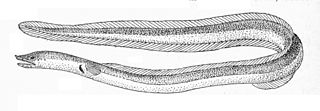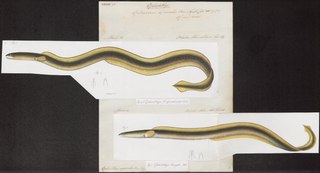
Ophichthus is a genus of eels in the snake eel family Ophichthidae.
The Maimed snake eel is an eel in the family Ophichthidae. It was described by Pieter Bleeker in 1857. It is a marine, tropical eel which is known from the Indo-Pacific, including the Red Sea, East Africa, Samoa, the Ryukyu Islands, Australia, and Micronesia. It dwells at a depth range of 1 to 13 metres, and inhabits coral reefs and lagoons, where it forms burrows in soft benthic sediments. Males can reach a maximum total length of 24 centimetres (9.4 in), but more commonly reach a TL of 8 centimetres (3.1 in).

The ordinary snake eel is an eel in the family Ophichthidae. It was described by Pieter Bleeker in 1864, originally under the genus Echelus. It is a marine, tropical eel which is known from the Indo-Western Pacific, including Vietnam, Japan, Fiji, the Marshall Islands, and Australia. It inhabits sandy sediments. Males can reach a maximum total length of 39 centimetres.
The Indo-Pacific slender worm-eel is an eel in the family Ophichthidae. It was described by Pieter Bleeker in 1857. It is a marine, tropical eel which is known from the Indo-Pacific, including the Red Sea, East Africa, the Line Islands, the Society Islands, Johnston Island, Japan, Rapa Iti, Micronesia, and the southern Great Barrier Reef. It forms burrows in inshore sediments of loose gravel and sand. Males can reach a maximum total length of 38 centimetres (15 in).
The slender snake eel is an eel in the family Ophichthidae. It was described by Pieter Bleeker in 1857. It is a marine, tropical eel which is known from the Indo-Pacific, including East Africa, the Society Islands, the Ryukyu Islands, and the Great Barrier Reef. It dwells at a depth range of 30 to 33 metres, and inhabits sand sediments, tidepools and swamps in mangroves. Males can reach a maximum total length of 25 centimetres (9.8 in).

The bluntnose snake eel is an eel in the family Ophichthidae. The author of the species is anonymous, but it has been referred to Edward Turner Bennett in 1830. It is a tropical, marine eel which is known from the Indo-Pacific, including Kenya, Madagascar, South Africa, Taiwan, Thailand, and the Philippines. It dwells at a maximum depth of 22 m, but also frequents shores. Males can reach a maximum total length of 45 cm.

The Napoleon snake eel is an eel in the family Ophichthidae. It was described by Johann Jakob Kaup in 1856, originally under the genus Poecilocephalus. It is a marine, tropical eel which is known from the Indo-Pacific, including Durban, South Africa, Mauritius, Indonesia, Japan, Australia, and the Penghu Islands. It is known to dwell at a depth of 20 metres (66 ft), and inhabits lagoons and reefs; it forms solitary burrows in sand sediments. Males can reach a maximum total length of 75 centimetres (30 in).
Ophichthus celebicus is an eel in the family Ophichthidae. It was described by Pieter Bleeker in 1856, originally under the genus Ophisurus. It is a marine, tropical eel which is known from the western Pacific Ocean, including India and Hong Kong.

The dark-shouldered snake eel is an eel in the family Ophichthidae. It was described by Pieter Bleeker in 1864. It is a tropical, marine eel which is known from the Pacific Ocean, including the East Indies, the Society Islands, the Mariana Islands, Queensland, the Marshall Islands, Micronesia, Japan, and India. It dwells at a depth range of 2–15 metres, and inhabits reefs. It forms burrows in mud and sand, and forages during the night. Males can reach a maximum total length of 115 centimetres.
Ophichthus congroides is an eel in the family Ophichthidae. It was described by John E. McCosker in 2010. It is a marine, deep water-dwelling eel which is known from the Tuamotu Islands, in the eastern central Pacific Ocean. It is known to dwell at a depth of 300 metres (980 ft). Males can reach a maximum total length of 52.2 centimetres (20.6 in), while females can reach a maximum TL of 47.2 centimetres (18.6 in).
The dusky snake eel is an eel in the family Ophichthidae. It was described by Camillo Ranzani in 1839. It is a tropical, marine eel which is known from the western Atlantic Ocean, including Cuba and Brazil.
Ophichthus lentiginosus is an eel in the family Ophichthidae. It was described by John E. McCosker in 2010. It is a marine, deep water-dwelling eel which is known from Vanuatu and New Caledonia, in the western central Pacific Ocean. It is known to dwell at a depth of 400 metres (1,300 ft). Males can reach a maximum total length of 62.8 centimetres (24.7 in), while females can reach a maximum TL of 56.3 centimetres (22.2 in).
The bigfin snake eel is an eel in the family Ophichthidae. It was described by Pieter Bleeker in 1853. It is a tropical, marine eel which is known from the Indo-Pacific. It dwells at a depth range of 0–25 metres, and inhabits sand and mud. Males can reach a maximum total length of 92 centimetres.
Ophichthus ophis, the spotted snake eel, is an eel in the family Ophichthidae. It was described by Carl Linnaeus in 1758, originally under the genus Muraena. It is a marine, subtropical eel which is known from the western and eastern Atlantic Ocean, including Bermuda and southern Florida, USA, Brazil, Lesser Antilles, Senegal, Angola, and the Mediterranean. It dwells at a depth range of 21 to 50 metres, usually at around 50 m, and lives in burrows on a permanent basis. Males can reach a maximum total length of 210 centimeters (83 in), but more commonly reach a TL of 100 centimeters (39 in).

The olive snake eel is an eel in the family Ophichthidae. It was described by Pieter Bleeker in 1853, originally under the genus Ophisurus. It is a marine, tropical eel which is known from the Indo-Pacific. It forms burrows in soft sediments in shallow waters, and leads a nocturnal lifestyle. Males can reach a maximum total length of 95 centimetres (37 in).
Ophichthus singapurensis is an eel in the family Ophichthidae. It was described by Pieter Bleeker in either 1864 or 1865. It is a marine, tropical eel endemic to Singapore. However, it is also possibly found in Thailand.
Ophichthus tomioi is an eel in the family Ophichthidae. It was described by John E. McCosker in 2010. It is a marine, deep water-dwelling eel which is known from the Indo-Pacific, including the Philippines, the Seychelles Islands, Marquesas, and Fiji. It dwells at a depth range of 300 to 423 metres. Males can reach a maximum total length of 44.7 centimetres (17.6 in).

The Pacific snake eel is an eel in the family Ophichthidae. It was described by Johann Jakob Kaup in 1856, originally under the genus Muraenopsis. It is a marine, subtropical eel which is known from the eastern central and southeastern Pacific Ocean, including California, USA, Peru, the Gulf of California, Mexico, the Galapagos Islands, Colombia, Ecuador, Costa Rica, El Salvador, Honduras, Guatemala, Nicaragua, and Panama. It dwells at a maximum depth of 155 metres (509 ft), and forms burrows in mud and sand sediments. Males can reach a maximum total length of 115 centimetres (45 in), but more commonly reach a TL of 80 centimetres (31 in).

The manetail snake eel is an eel in the family Ophichthidae. It was described by Coenraad Jacob Temminck and Hermann Schlegel in 1846, originally under the genus Conger. It is a marine, tropical eel which is known from the Indo-Pacific. It inhabits deep waters, but is found in muddy sediments in shallow waters on rare occasions. Males can reach a maximum total length of 61.5 centimetres (24.2 in).
Hoeven's snake eel is an eel in the family Ophichthidae. It was described by Pieter Bleeker in 1853, originally under the genus Ophisurus. It is a marine, tropical eel which is known from three specimens found in the Indo-Western Pacific, including Sulawesi, Indonesia, the Persian Gulf and the Gulf of Oman. It is known to inhabit shallow water and lagoons. Males are known to reach a total length of 22 centimetres (8.7 in).





